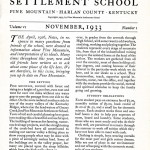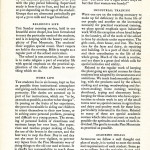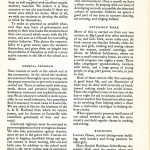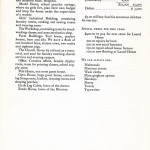Pine Mountain Settlement School
Series 17: PUBLICATIONS PMSS
NOTES 1933
November
NOTES – 1933
“Notes from the Pine Mountain Settlement School”
November
Similar to the 1926 edition of NOTES, the 1933 November issue provides an overview of the School and describes the programs, staff, farm program, physical facilities and budget. This edition also describes the ideals of the school in 1933 and what the School is attempting to do in pursuing the mission of the institution.
GALLERY: NOTES 1933 November
We believe it is false economy to use old text-books if there are newer ones which are better.
- NOTES – 1933 November, page 1. [PMSS_notes_1933_nov_001.jpg]
- NOTES – 1933 November, page 2.[PMSS_notes_1933_nov_002.jpg]
- NOTES – 1933 November, page 3.[PMSS_notes_1933_nov_003.jpg]
- NOTES – 1933 November, page 4.[PMSS_notes_1933_nov_0041.jpg]
TAGS: NOTES – 1933 NOVEMBER: Pine Mountain setting, Pine Mountain family, students, workers, student obligations, fees, tuition, clothing, week-day schedule, religious life, Chapel, choir, vespers, non-sectarian, home life, housemother, cleanliness, manners, industrial work, vocational training, printing, housekeeping, woodworking, furniture making, home nursing, weaving, secretarial skills, farming, academic ideals, assembly periods, textbooks, schoolhouse atmosphere, student council, discipline, medical program, examinations, L & N Railroad, Louisville doctors, epidemics, health courses, medical aid, recreation, games : sports : parties, silent movie, mountain culture, extension work, Big Laurel, Line Fork, Medical Settlement, community service, buildings, financial report, budget
TRANSCRIPTION: 1933 November
P. 1
NOTES FROM THE
PINE MOUNTAIN
SETTLEMENT SCHOOL
PINE MOUNTAIN * HARLAN COUNTY * KENTUCKY
Copyright, 1933, by Pine Mountain Settlement School
Volume VI NOVEMBER, 1933 Number I
The April, 1926, Notes, in response to many questions from friends of the school, were devoted to information about Pine Mountain, and interpretation of its ideals. Many times throughout this year, new and old friends have written us to ask about some phase of the life here. We are therefore, in this issue, bringing you up to date on Pine Mountain.
THE SETTING
PINE MOUNTAIN, covered with forest and rising to a height of 3,000 feet, runs east and west for over 100 miles without any water gap to ease the passage from one side to the other. On the more isolated northern side in one of the many valleys of the Kentucky Ridges, where rise the headwaters of Greasy Creek, lies Pine Mountain Settlement School. Years of toil and careful planning have gone into making this a beautiful and useful spot. The building of terraces for farming, numerous drainage projects, and the straightening of the creek-bed have all contributed to making our narrow valley a fitting place to show young people what may be done with a piece of seemingly useless land. Some of the buildings are in the valley proper, but many are placed upon the steep hillsides which form the high walls about us.
THE FAMILY
HERE from August to May live over a hundred young people fourteen years old and over, in grades from the seventh through High School, with some twenty odd workers, studying, working and playing together. The students represent every stage of mountain life, from that of the industrialized mining camp to the isolated home at the head of the hollow. The workers are gathered from all over the country, most of them holding college degrees, and coming because of their interest in the particular work which we do here, and in our ideals as a school. They housemother, teach, supervise special industries, nurse, run the office, and together with the students provide the social, mental and spiritual stimulus to keep the family going and growing.
STUDENT OBLIGATIONS
EACH student pays an entrance fee of $5.00, monthly tuition of $3.00, book rental of $1.00 or $1.50, and a small fee for domestic science. Each student works three and one-half hours a day to help pay expenses room, board and laundry. Some students, those who are most needy and who do their work well, are permitted to remain through the summer to work off tuition which they have not been able to meet with cash.
Clothing is simple, boys wearing overalls for the most part and girls cotton dresses. Silks are out of place in our environment and out of keeping with the economic standards of our students.
WEEK-DAY SCHEDULE
THE rising bell rings at 6:10 and breakfast is at 6:40. During the ten minutes before breakfast…
[1]
P. 2
…the students make their own beds and do the small chores about their sleeping porches. After breakfast the Junior high school is in session and high school students go to work. This is reversed after dinner, and the whole schedule is changed after Christmas. Dinner is at 11:30 and is followed by the assembly period. Supper is at 5:00 with the play period following. Supervised study is from 6:30 to 8:00, and bed at 8:30 or 9:00 depending on the age of the student. Groups that are alternated periodically get up at 4:30 to milk and to get breakfast.
RELIGIOUS LIFE
THE Sunday morning service, held in our beautiful stone chapel, has been formulated to meet the particular needs of the students, and is in keeping with the beauty and simplicity of Pine Mountain. The students’ choir supplies special music. Short vespers are held in the evening. Bible is taught as a regular part of the school curriculum.
The school is non-sectarian, but our aim is to make religion a part of everyday life with special emphasis on the practical application of the ethics of Jesus in everything which we do.
HOME LIFE
THE students live in six houses, kept as free as possible from institutional atmosphere and giving each housemother a world of opportunity. Her duties are summed up in part of her instructions, which are “to be, as much as possible, a mother to her charges”. In passing on the fruits of her experience, she proves invaluable in aiding our children to orient themselves to their new home, or in solving some personal problem, pressing and difficult to a young person. The stressing of personal habits of cleanliness and neatness keeps her ever busy. She supervises and teaches proper making of beds, the use of the broom in the corner, and the best way to mop the floor. Day in and day out she must be ever vigilant, to prevent any lapses from the Pine Mountain way of doing things to the old one used at home. It is chiefly her responsibility to teach those little niceties which are sometimes lacking. “Pap would fight for mam” one of our children said, “But law, he wouldn’t fetch her a kittle o’ water — fetchin’ and carryin’ — them’s woman’s work!” In our families the boys learn to carry others’ books, step aside for ladies, hold open doors.
In brief the housemother is the hub of the home wheel. One of the boys put it rightly when, after a fierce bolt of lighting had struck a tree near Boys’ House, he said “The Lord war a right smart ways off but that thar woman war handy!”
INDUSTRIAL TRAINING
WITH one eye on the training necessary to make up for deficiency in the home life of our people and another on the increasing necessity for practical vocational training, we place special emphasis upon industrial work. With the exception of one hired helper in the laundry, all of the work of the school is done by students under supervision. The girls cook, clean house, and iron. The boys care for the farm and dairy, do repairing and building. It is a part of their training and their contribution to the life of the whole group. Much of the work is routine, and yet there is a great deal which calls for special initiative and ability.
Related to the regular work of keeping the plant going are special courses for those students best adapted by circumstances and ambitions. We teach fundamentals of printing, with the products used by the school; cooking and sewing; woodworking and furniture-making; home nursing; weaving; shorthand, typing and elementary book- keeping for those students who have opportunities to obtain work in any of the small towns near us; special courses in agriculture and dairy and poultry work for those boys particularly interested in the farm. Related to many of these are special academic courses which take into account as much as possible the aptitudes and needs of each individual. The goal is to make Pine Mountain as practical as possible.
ACADEMIC IDEALS
ALTHOUGH we follow a well thought out plan of study, it is varied to meet the needs and requirements of each student. Some go on to college, but the majority do not, and it is for these that our curriculum is made. With this in mind we emphasize only that which we feel is absolutely necessary as a key for an understanding and appreciation…
[2]
P. 3
…of the world in which we live and the problems most intimate to ourselves.
The schoolhouse atmosphere is very much alive. There is enough intimacy between student and teacher to make good discussion possible. Assembly periods are used for the development of the student’s initiative. We have a fairly good library, and our friends keep us well supplied with excellent supplementary material. We believe it is false economy to use old text-books if there are newer ones which are better. Most of all, we wish our students to develop the ability to think for themselves.
To make as practical as possible whatever they may learn of government and society in their text-books the students have their own council which meets with the Director, and acts as a tribunal for controlling student behavior. This places the responsibility to a great extent upon the students themselves, and gives them an insight into the problems of discipline as well as a more active interest in the life of the school as a whole.
MEDICAL PROGRAM
THIS consists of work at the school and in the community. At the school the students are examined thoroughly upon entering and the proper corrective or preventive measures carried out. There is routine work with eyes, teeth, throat and personal hygiene, also hookworm treatment and typhoid inoculation. We do whatever corrective work is possible in our small infirmary, but sometimes find it necessary to send cases to Louisville. We are aided in this by the kindness of the L. & N. Railroad from which we receive passes, and by doctors at Louisville who contribute generously of time and material.
Continual vigilance must be exercised to prevent epidemics of any contagious disease. We also take precautions against thyroid, since we are in the goitre belt. Courses are given in hygiene, healthful living and special courses in home nursing, first aid and baby care. In addition to the school work there is the never ending task of supplying medical aid to a community of 300 square miles where sanitation and health habits are practically unknown, and where local medical ideas belong to an age long past.
RECREATION
Nor very much time for play, but every available moment packed with games and sport. Swimming in season; indoor baseball, basket-ball, hikes and picnics all go to make every minute worthwhile. On special holidays we have costume parties and make our own entertainment. Once a month we have a silent movie. In keeping with our ideal of developing as much as possible the inherited culture of mountain children we spend a good part of our time in country dancing, set running, and singing ballads.
EXTENSION WORK
Most of this is carried on from our two centers, at Big Laurel four miles northwest of us, and Line Fork, seven miles east. At both centers are Sunday Schools, clubs for boys and girls, cooking and sewing classes for the women, mothers’ meetings, and clinics. At Medical Settlement, where we have a small community house, we carry on a social program two nights a week. There folks congregate — grandmothers, mothers with babes, and a large group of young people, to sing, play games, run sets, or just to visit.
Both of these centers offer fine examples in good home life, and are illustrative of what may be done with materials at hand, toward making simple but model homes. There the neighbors come at any time of the day or night for aid in sickness and trouble, and our workers find themselves called upon to do anything from helping select a dress from a mail-order catalogue to helping deliver a baby.
When opportunity presents itself some of our school workers go out into the community and hold regular classes in cooking and sewing.
BUILDINGS
LAUREL House, central dining-room building, with laundry and living quarters for older girls.
Mary Sinclair Burkham Schoolhouse. Assembly Hall, used for parties, plays and moving pictures, five class rooms and library. Far House, home of older girls and four workers.
Old Log House, workers’ dwelling place.
[3]
P. 4
Big Log House, home of younger girls and three workers.
Boys House, home of younger boys and four workers.
Farm House, home of older boys and one worker.
The Infirmary, home of nurse. Wards, and isolation room. Hospital.
Model Home, school practice cottage, where six girls live, plan their own budget and keep the house under the supervision of a worker. [Later known as Practice House and Country Cottage.]
Girls’ Industrial Building, containing laundry rooms, cooking and sewing rooms and weaving room.
The Workshop, containing room for woodworking classes and auto-mechanics shop.
Farm Buildings: Tool house, poultry houses, barn and silo. We have a flock of one hundred hens, sixteen cows, two mules and eighteen pigs.
The Church. [Chapel] Given by a friend as a memorial, and used for Sunday morning church services and evening vespers.
Office. Contains offices, fireside display room, room for printing classes, school supply store.
Pole House, one room guest house.
Open House, large guest house, containing living room, kitchen, dressing rooms and sleeping porches.
Little Log Cabin, home of the doctor.
Zande House, home of the Director.
Budget — 1933-1934…………………………………………$30,000
Annual Subscriptions…………………………$ 8,000
Cash contributions regularly expected….9,000
$17,000
Endowment fund, approximately………….8,000
$25,000 25,000
Deficit…………………………………………………………………$5,000
$5.00 will buy food for seventeen children for one day.
SPECIAL NEEDS FOR THIS YEAR:
$400.00 to pay for new stove for Laurel House
200.00 repairs for barn
500.00 new set of batteries
250.00 repair school house furnace
100.00 new flooring at Laurel House
WE CAN ALWAYS USE:
Dishtowels
Mattress covers
Wash cloths
Plain gingham aprons
Blankets
Sheets
Towels
Typewriter
[4]
The Marchbanks Press, New York
Previous:
NOTES – 1932
Next:
NOTES – 1934 [NO ISSUES FOUND]
See Also:
BUILT ENVIRONMENT Guide
MEDICAL Guide
RELIGION Guide
Return To:
NOTES – INDEX





